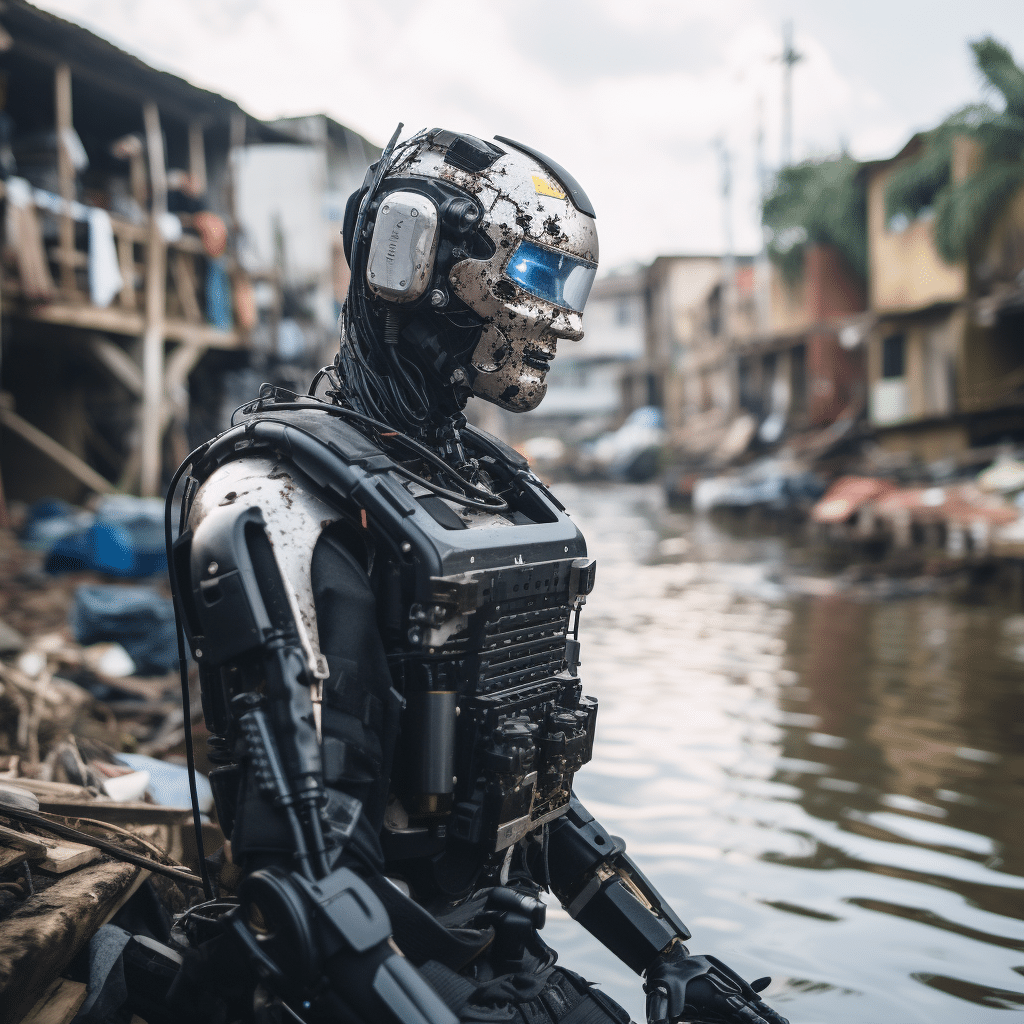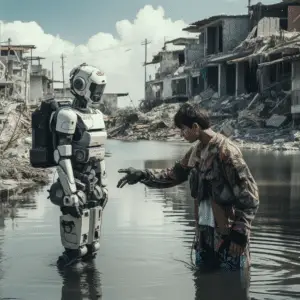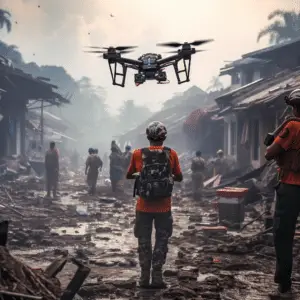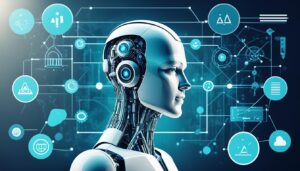
In the face of natural disasters and humanitarian crises, leveraging the power of Artificial Intelligence (AI) has become increasingly crucial for effective relief efforts and aid delivery. AI technologies provide valuable capabilities that can aid in disaster response, recovery, and mitigating future risks, ultimately helping to save lives and support vulnerable populations.

1. Rapid Data Analysis and Decision Making
AI algorithms can swiftly analyze vast amounts of real-time data collected from various sources, including satellite imagery, social media, and sensors. This analysis helps in identifying affected areas, determining the scale of the disaster, and assessing critical needs. Such data-driven insights enable relief organizations to make informed decisions quickly, optimizing resource allocation and aid distribution.
2. Prediction and Early Warning Systems
AI-powered predictive models can assess historical data to identify patterns and forecast potential disasters, such as hurricanes, earthquakes, and droughts. By utilizing machine learning algorithms, early warning systems can be developed to alert communities and governments, allowing them to take preventive measures, evacuate affected regions, and establish emergency response plans.
3. Autonomous Robotics in Rescues
Robots equipped with AI capabilities can navigate hazardous environments, enhancing disaster response operations. Drones can be deployed for swift aerial assessments, delivering supplies to stranded populations, and conducting search and rescue missions. Additionally, ground-based robots can provide assistance in searching collapsed buildings or areas deemed too dangerous for human intervention.
4. Natural Language Processing for Communication
In multilingual disaster scenarios, language barriers can hinder effective relief operations. Natural Language Processing (NLP) technologies enable AI systems to process and analyze communication data in real-time, facilitating translation services, sentiment analysis, and information extraction from social media posts or emergency calls. This assists aid workers in understanding affected populations’ needs swiftly.
5. Efficient Resource Management
AI algorithms can optimize logistics and supply chain management during humanitarian crises. By considering variables like time, cost, and urgency, AI can provide recommendations for efficient routes, inventory management, and resource allocation. Smart systems can also monitor and predict essential resource requirements, ensuring aid organizations can respond promptly.
Conclusion
Artificial Intelligence is no longer futuristic speculation but a practical tool in the field of disaster relief and humanitarian aid. Integration of AI technologies improves response time, enhances data analysis capabilities, and streamlines resource allocation. Embracing AI in disaster management enables organizations to better protect at-risk communities, mitigate the impacts of disasters, and ultimately save more lives.
How can AI be leveraged to enhance the efficiency and effectiveness of disaster relief efforts?
AI can improve disaster response in many ways:
1. Early warning and prediction: AI can scan enormous volumes of data from satellite imagery, weather reports, social media, and historical data to detect patterns and anticipate disaster likelihood and severity. This information aids early detection, planning, and evacuation.
2. Resource management: Based on real-time data analysis, AI can optimize food, water, medical supplies, and rescue teams. It can incorporate population density, infrastructure, and accessibility to optimize resource use and distribution.
3. Damage assessment: AI can quickly assess disaster damage by analyzing aerial and satellite photographs. It can identify critical regions, prioritize rescue operations, and direct relief efforts.
4. Communication and coordination: AI-powered chatbots and virtual assistants can connect impacted people to emergency services and offer safety advice in real time. Chatbots can help relief personnel organize and manage their responsibilities.
5. AI-based drones and robots can aid search and rescue operations, especially in hard-to-reach places. These autonomous systems can negotiate debris, scan impacted areas, and relay vital information to rescue crews, speeding up relief efforts.
6. Data analysis and decision-making: AI can analyze massive volumes of data from numerous sources, including social media, to deliver real-time insights into the unfolding crisis situation. This information can assist decision-makers create effective response strategies, monitor relief operations, and adjust their plans.
AI can improve disaster relief efforts by improving reaction times, prediction accuracy, resource allocation, and stakeholder coordination.
How might AI help early warning systems and disaster prediction improve planning and response?

AI can play a significant role in early warning systems and predicting future disasters, ultimately enhancing preparation and response efforts.
1. Data collection and analysis:
AI can gather and analyze vast amounts of data from various sources in real-time, including satellite imagery, weather reports, sensor data, social media feeds, and historical records. This enables the identification of patterns, trends, and anomalies that can help predict and detect potential disasters.
2. Risk assessment and prediction models:
Using machine learning algorithms, AI can create predictive models that assess the risk of specific disasters, such as floods, hurricanes, wildfires, or disease outbreaks. These models consider multiple variables, such as environmental conditions, population density, infrastructure vulnerabilities, and historical data. By continuously updating and refining these models, AI can provide more accurate and timely predictions.
3. Early warning alerts:
AI-powered systems can automatically generate early warning alerts when potential disasters are detected. These alerts can be sent to authorities, emergency responders, and individuals at risk, enabling them to take proactive measures and evacuate if necessary. AI can also streamline and automate the dissemination of these alerts through various communication channels, increasing their reach and effectiveness.
4. Resource allocation and planning:
AI algorithms can analyze historical data and simulations to optimize resource allocation and emergency response planning. By considering factors like population density, geography, infrastructure, and available resources, AI can suggest efficient evacuation routes, determine the best locations for emergency shelters, and optimize the distribution of supplies and personnel during disaster response.
5. Real-time situational awareness:
AI-powered systems can continuously monitor and analyze data streams from various sources to provide decision-makers with real-time situational awareness during a disaster. This includes predicting the path of a hurricane, assessing the spread of a wildfire, or monitoring the progression of an epidemic. Such insights enable better decision-making and aid in coordinating response efforts in impacted areas.
6. Post-disaster analysis:
AI can contribute to the post-disaster analysis by crunching data and generating insights on the impact, response, and recovery activities. By analyzing various data sources, including satellite images and social media data, AI can help identify areas that require immediate assistance, assess infrastructure damages, and evaluate the effectiveness of emergency response strategies. These insights can facilitate better preparation for future disasters.
In summary, AI can significantly contribute to early warning systems and prediction of future disasters by leveraging data analysis, risk assessment models, real-time alerts, resource optimization, situational awareness, and post-disaster analysis. By enhancing prediction accuracy and response efficiency, AI can help save lives, reduce the impact of disasters, and improve overall disaster preparedness.
What are some specific applications of AI in the field of humanitarian aid and disaster response?
AI applications in humanitarian relief and catastrophe response include:
1. Early warning systems: AI can use sensors, satellites, and social media data to predict earthquakes, floods, and disease outbreaks. These systems allow evacuation and prevention.
2. Predictive analytics: AI algorithms can evaluate data and patterns to predict future disasters and their impact. This information helps assistance organizations and governments better allocate resources and plan responses.
3. Disaster damage assessment: AI methods like computer vision can help. AI systems can evaluate drone photographs of affected areas to detect damaged buildings, infrastructure, and locations that need quick care.
4. Resource allocation: By assessing real-time population density, infrastructure, and urgent demands, AI can optimize resource allocation in disaster-stricken places. It helps aid groups prioritize and allocate food, water, medicine, and manpower.
5. Natural-language processing: AI-powered chat-bots or voice assistants can interpret and respond to queries from affected people during emergencies, offering vital information, guidance, and support. They address frequent issues, provide emergency contact information, and guide them to nearby aid centers.
6. Disease outbreak tracking: AI can track and anticipate disaster-related disease outbreaks by analyzing data from multiple sources. It lets public health officials set up medical facilities, distribute immunizations, and deploy healthcare professionals.
7. Real-time social media analysis: AI systems can monitor social media posts and data to understand affected populations’ requirements. This information helps responders grasp the situation, discover new issues, and adapt their aid.
8. Emergency communication systems: AI can translate communications between languages during disasters. It eliminates language barriers and helps responders communicate with affected communities.
AI can improve catastrophe response speed, resource allocation, and community support.









Thanks for sharing. I read many of your blog posts, cool, your blog is very good.